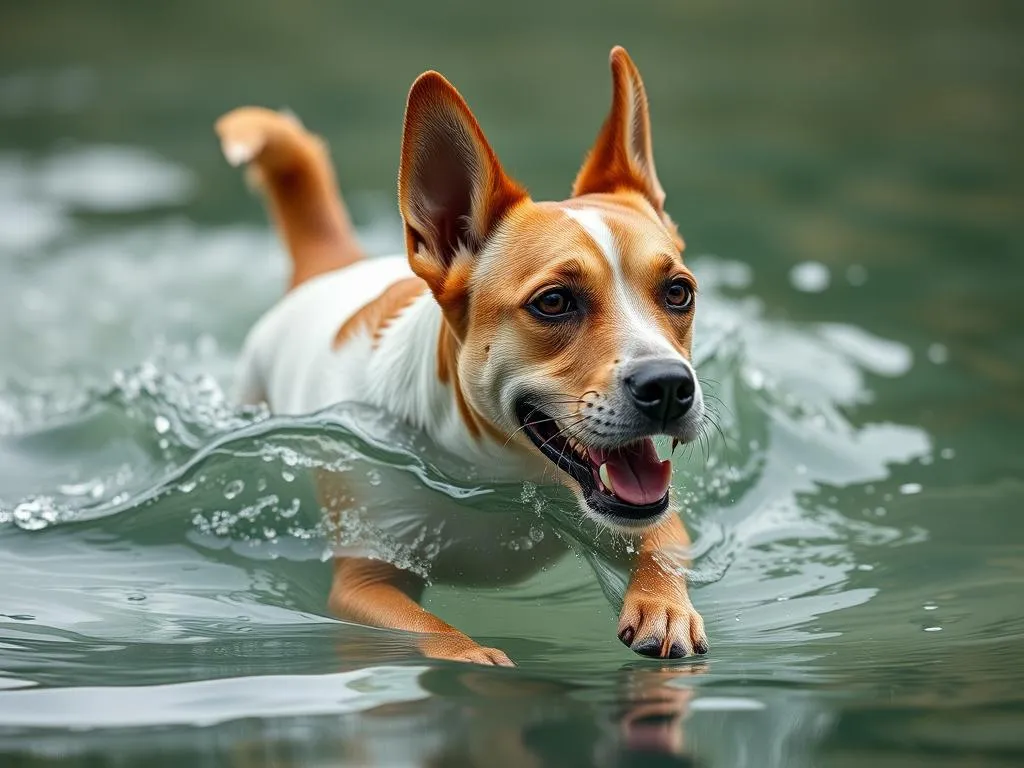
Understanding whether dogs can swim without training is a crucial question for many dog owners, especially those who enjoy aquatic activities. While some dogs exhibit a natural affinity for water, others may struggle or even panic in such situations. In this guide, we will explore the innate swimming abilities of dogs, factors influencing these abilities, safety considerations, and the importance of training.
Understanding a Dog’s Natural Instincts
The Instinct to Swim
Many dog breeds possess an instinctual ability to swim, a trait inherited from their ancestors. This natural behavior can be observed in various breeds that have historically been used for water retrieval or as working dogs. Breeds such as Labrador Retrievers, Newfoundlands, and Chesapeake Bay Retrievers are renowned for their swimming prowess. These dogs often display a natural paddling motion when they enter the water, making swimming seem effortless.
Factors Influencing Swimming Ability
While some dogs may possess an innate ability, several factors can influence their actual swimming skills:
-
Age and Physical Condition: Younger dogs and those in good physical health are generally more agile and can adapt to swimming more easily. Older dogs or those with health issues may not be able to swim as effectively.
-
Breed Characteristics: Certain breeds are genetically predisposed to swim better than others. For instance, breeds with webbed feet or a strong build often excel, while brachycephalic breeds (like Bulldogs and Pugs) may struggle due to their body structure.
-
Previous Exposure to Water: Dogs that have been introduced to water at a young age or have had positive experiences in aquatic environments are more likely to swim confidently. Conversely, negative experiences can lead to fear or anxiety around water.
Safety First: Assessing Your Dog’s Swimming Skills
Signs Your Dog May Be a Natural Swimmer
Before encouraging your dog to swim, it’s essential to assess their natural abilities. Here are some signs indicating they might be a natural swimmer:
-
Body Structure and Coat Type: Dogs with a streamlined body and water-resistant coat often have an advantage. Breeds like Retrievers and Spaniels are designed for swimming, having the right build for buoyancy and propulsion.
-
Behavior Around Water: If your dog exhibits excitement or curiosity when near water, this may indicate a natural inclination to swim. Conversely, if they show signs of fear or anxiety, extra caution is necessary.
Understanding the Risks
Even if a dog appears to be a natural swimmer, it’s critical to recognize potential hazards:
-
Drowning Hazards: Not all dogs are excellent swimmers, and even those that are can face danger, especially in unfamiliar or turbulent waters.
-
Water Toxicity and Environmental Dangers: Bodies of water can harbor harmful bacteria, parasites, or chemicals that may pose health risks to dogs.
-
Importance of Supervision: No matter a dog’s swimming ability, constant supervision is essential to ensure their safety while they are in or near water.
The Role of Training in Swimming
Benefits of Training Your Dog to Swim
While some dogs may swim without training, there are significant benefits to teaching them proper swimming techniques:
-
Building Confidence in the Water: Training helps dogs feel more secure and reduces anxiety, making swimming a more enjoyable experience.
-
Reducing Anxiety and Fear: Dogs that have had negative experiences with water can overcome their fears through gradual and positive exposure.
-
Teaching Safety Commands: Training allows you to teach your dog essential commands, such as “come” or “stay,” that can be lifesaving in aquatic situations.
Basic Swimming Techniques to Teach
If you decide to introduce your dog to swimming, here are some basic techniques to consider:
-
Introduction to Water: Start by allowing your dog to get used to shallow water before moving to deeper areas. Encourage them to step in gradually.
-
Encouraging Paddling with Toys: Use floating toys to motivate your dog to paddle and retrieve, making the experience fun and engaging.
-
Using Life Vests for Extra Safety: Particularly for dogs that are not confident swimmers or for breeds that struggle, a life vest can provide extra buoyancy and peace of mind for both the dog and owner.
Can All Dogs Swim Without Training?
Breeds That Excel at Swimming
Certain breeds are renowned for their swimming capabilities. Here are a few that are considered natural swimmers:
-
Labrador Retrievers: Known for their love of water, these dogs have a muscular build and a waterproof coat that makes them exceptional swimmers.
-
Newfoundlands: With their large size and webbed feet, Newfoundlands are often referred to as “gentle giants” and are known for their remarkable swimming ability.
-
Portuguese Water Dogs: These dogs were bred for work on fishing boats, and their strong swimming skills are complemented by their agility and intelligence.
Breeds That Struggle with Swimming
While many breeds thrive in water, others may face challenges. Here’s a look at some of them:
-
Brachycephalic Breeds: Dogs like Bulldogs, Pugs, and Boxers have short snouts and broad bodies, which can hinder their ability to swim efficiently. They may tire quickly and struggle to keep their heads above water.
-
Small Breeds: Tiny dogs, such as Chihuahuas and Dachshunds, may not have the physical strength or buoyancy to swim effectively and can easily become overwhelmed in water.
It’s essential to exercise caution with these breeds and always supervise them when near water.
The Importance of Supervision and Safety Gear
Always Supervise Your Dog
Constant supervision is perhaps the most important aspect of water safety for dogs. Here’s why:
-
The Necessity of Constant Oversight: Even the best swimmers can encounter difficulties. Always be present to monitor your dog’s behavior and ensure they are safe.
-
Signs of Distress in Dogs While Swimming: Keep an eye out for signs of fatigue, distress, or panic, such as excessive splashing, inability to paddle, or barking. If you notice these signs, assist your dog immediately.
Recommended Safety Gear
Investing in safety gear can significantly enhance your dog’s safety while swimming:
-
Life Jackets for Dogs: A properly fitted life jacket can provide buoyancy and help dogs stay afloat, especially those that are not strong swimmers.
-
Other Safety Tools: Consider using leashes or flotation devices to maintain control and enhance safety while your dog is in the water.
Making Swimming a Positive Experience for Your Dog
Gradual Introduction to Water
To ensure a positive swimming experience, it’s vital to introduce your dog to water gradually:
-
Tips for Easing Your Dog into Swimming: Start with shallow water and allow your dog to explore at their own pace. Use treats and praise to encourage them to enter the water.
-
Positive Reinforcement Methods: Reward your dog for positive behavior in the water, such as paddling or retrieving toys, to foster confidence.
Fun Water Activities to Enjoy Together
Swimming isn’t just about getting wet; it can also be a fun bonding experience for you and your dog. Here are some activities to consider:
-
Suggested Games and Activities in the Water: Playing fetch with a floating toy or setting up a mini obstacle course in shallow water can make swimming enjoyable for your dog.
-
Benefits of Joint Exercise for Both Dog and Owner: Swimming is a low-impact exercise that can improve both your fitness levels. It’s an excellent way for you to stay active while spending quality time with your furry friend.
Conclusion
In summary, while some dogs can swim without training due to their natural instincts, many factors influence their swimming abilities. Understanding your dog’s breed characteristics, behavior around water, and physical condition is essential for assessing their swimming skills. Regardless of their natural abilities, safety should always be a priority. Training can significantly enhance your dog’s confidence and skills in the water, making the experience enjoyable and safe for both of you.
Ultimately, every dog is different. As a responsible owner, it’s crucial to evaluate your dog’s individual abilities and ensure a safe and positive swimming experience. Prioritizing safety while enjoying water activities with your dog not only protects them but also allows for a fulfilling and enjoyable time in the great outdoors.









